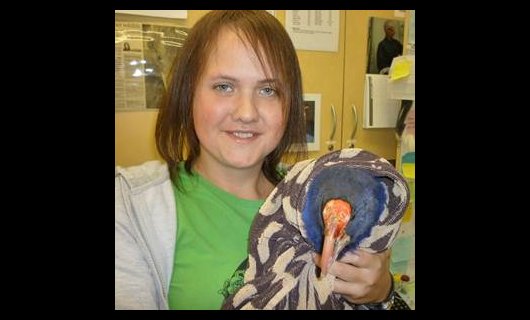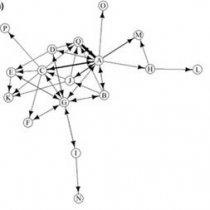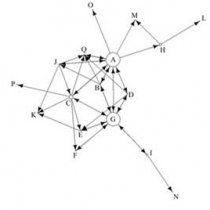Identification of populations for disease surveillance in a translocated network of endangered Takahe
by Zoe Grange

Zoë Grange
PhD Candidate, Allan Wilson Centre, mEpilab, Wildbase and Victoria University of Wellington
Social network analysis is being increasingly used in epidemiology and disease modelling in humans, domestic animals, and wildlife. We investigated this tool in describing a translocation network (area that allows movement of animals between geographically isolated locations) used for the conservation of an endangered flightless rail endemic to New Zealand, the Takahē (Porphyrio hochstetteri).
The takahē was believed to be extinct until it was rediscovered in the Murchison Mountains, Fiordland in 1948. Subsequently, individuals were moved into offshore predator free reserves to ensure their survival. With a current population of approximately 230 individuals, active conservation management involving multiple translocations per year is required to reduce the detrimental effects of inbreeding. The extent of isolation and human mediated mixing of individuals may influence the dynamics of pathogen prevalence and transmission in the population as a whole. As such analysis of the population in terms of subpopulations and their connectivity to each other can provide insight into the epidemiology of pathogen transmission and identify locations for disease surveillance.
Five years of takahē translocation records within New Zealand were collated and social network principles were applied to describe the connectivity of the translocation network (Figure 1). Common network descriptors and measures of centrality highlighted key locations for targeting disease surveillance. Identification of sink (wild population) and source (offshore island) locations were important in understanding potential pathogen evolution and disease threats. Additionally, the breeding centre acts as a hub of the network, an intermediary between many takahē subpopulations, thus important in pathogen transmission.
The analysis has found that the takahē network is highly variable in terms of subpopulation connectivity, which has implications on understanding the epidemiology of past, present and future disease threats. The visual representation of movements of animals in a population that this technique provides can aid decision makers when they evaluate translocation proposals, conduct pathogen surveillance or attempt to control a disease outbreak.
This work has been published in Conservation Biology and is available online.
Grange, Z., van Andel, M., French, N.P., & Gartrell, B. 2014. Social networking of an endangered flightless bird and its use in targeting disease surveillance. Conservation Biology, doi: 10.1111/cobi.12178


a) b)
Figure 1: Node (circles) and tie (lines) networks of cumulative Takahē translocations from 2007 to 2011: (a) tie weight between locations (the thicker the line, the more translocations between 2 directly connected locations) and (b) weighted betweenness for individual locations (i.e., measure of centrality determining the likelihood of a node connecting 2 random nodes via the shortest path while accounting for node strength [sum of node weights] of an individual node). Nodes are isolated geographic locations used for Takahē conservation. Lines with either uni- or bidirectional arrows show the direction of human-mediated Takahē translocations between locations. Size of the circle illustrates extent of centrality; the larger the node, the more central the location in the network (A, Burwood Bush breeding center; B, Kapiti Island; C, Mana Island; D, Maud Island; E, Maungatautari reserve; F, Pukaha Mt Bruce; G, Wildbase Hospital; H, Private island; I, Te Anau wildlife reserve; J, Tiritiri Matangi Island; K, Motutapu Island; L, Peacock Springs wildlife park; M, Secretary Island; N, Wellington Zoo; O, Willowbank reserve; P, Zealandia / Karori Sanctuary; Q, Murchison Mountains).